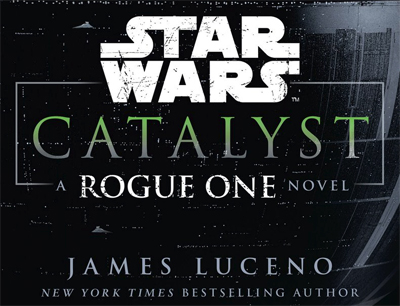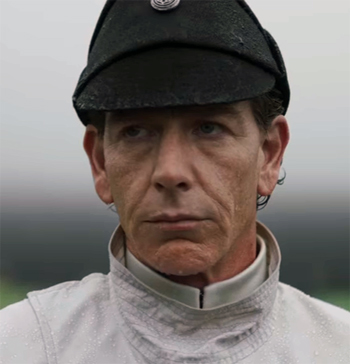 It’s a unique time in the life of Catalyst: A Rogue One Novel. The book is, as the name indicates, a direct tie-in to Rogue One, a movie which is not even out in theaters for another few weeks. We still do not know the extent of how the two works will tie in together, what from one will show up in the other or how much one work may lean on the other for support in character development or story. Thus, this will be an examination of the book on its own merits rather than as a tie-in.
It’s a unique time in the life of Catalyst: A Rogue One Novel. The book is, as the name indicates, a direct tie-in to Rogue One, a movie which is not even out in theaters for another few weeks. We still do not know the extent of how the two works will tie in together, what from one will show up in the other or how much one work may lean on the other for support in character development or story. Thus, this will be an examination of the book on its own merits rather than as a tie-in.
Let’s start with overall impressions before we get into what might be considered spoiler territory. Catalyst is written by James Luceno in the grand tradition of Luceno Star Wars novels, in that it ties to the larger events of a film or other project while still telling its own story. Catalyst is very much a prequel, but it tells its own tale well enough to not need the help of the film to support it. It does, however, give context to larger events by taking us behind the scenes, as it were. In this case, we go behind the scenes of the creation of the Empire’s first superweapon.
Through the novel we follow three characters, Galen Erso and his wife Lyra, along with their “friend” and greatest supporter Orson Krennic. The relationship between the three is complicated and ever-evolving as the galaxy spins, events unfold and everything changes around them. We follow our dysfunctional trio from the midst of the Clone Wars through the end of the war to the midst of the Galactic Empire, but the true strength of the book isn’t in the myriad of references or hints at things yet to come; its strength is the leads and the choices they make, the characters themselves bearing the weight of the story.
 Our Important Few
Our Important Few
Orson Krennic is undoubtedly the villain of the book, but he is far more the Tarkin mold of villain than the Vader, charismatic and even affable when he wants to be. It’s his machinations that put most of the key events of the novel into motion, and it’s only when things don’t go the way he predicted that the charming sophistication goes away to reveal the sociopath underneath. Krennic excels at reading and manipulating people, from the lowliest smuggler all the way up to Mas Amedda himself, and throughout the story his naked ambition is hidden only by his skill in getting others to act for him, out of what they think is their own best interest.
Chief among those Krennic manipulates, and one of the few to genuinely call him a friend for a time, is Galen Erso. Galen is a genius, and rather close to being a mad one. He loses himself in equations and formula, vanishing into his own headspace for days at a time. In a realistic touch, though, he does not try to be difficult or insufferable, he simply does not relate to people as well as the tidy, ordered mystery of mathematics and endless realms of scientific study. He is fascinated by the kyber crystals that seem to defy science in so many ways and devotes all of his considerable mental capacity to decipher their secrets, research that takes a dark turn once Krennic begins to whisper in his ear.
His assistant and translator, and the book’s standout character, is Galen’s wife Lyra. Lyra is noted in the book as being Galen’s opposite, but it would be more accurate to call her his foundation. She keeps him grounded, makes sure he keeps one foot in reality, and gives him something for his mind to focus on as a consequence of his research beyond his lab. More than that, she is a strong woman, not likely to back down from what she sees as a righteous stand. A firm believer in the Force and the strength of the natural world, it’s her influence that is ultimately the greatest obstacle to Krennic getting what he wants.
 Spinning the Story
Spinning the Story
It’s an interesting story as the relationship between science and the Force is explored by people who aren’t Jedi. Lyra is in tune with the Force, but she is not a Jedi, or even a scientist. Galen believes that the Force exists, but it being an unquantifiable entity drives him to even greater lengths to figure out what makes things like the kyber crystals, things imbued with properties beyond what science can easily explain, special. The two of them dream of using the same crystals that fuel Jedi lightsabers to provide clean, free energy to a galaxy ravaged by war, to give it some means to heal, to redevelop. Even once the Jedi disappear, that dream continues as Lyra encourages Galen to carry on the Order’s work in a new way.
Of course, we would not have a story if that dream came true. The novel’s crux of drama is Krennic’s ongoing manipulation, the world of lies and half-truths that he enmeshes Galen and Lyra in so he can use Galen’s research for his own ends. Looking at the cover of the book will give you a good idea of what those ends are, but the tale is, of course, in the telling. As Krennic tries to harness Galen’s genius to in turn promote his own advancement, he uses everyone he can to keep the masquerade intact, from former Separatists to rival Imperial officers. At the same time, Lyra tries to balance her concern for her husband, caring for their daughter, and her suspicion of Krennic’s intentions. We will leave the book’s many twists and turns unspoiled, but suffice to say if you enjoy the sort of thrillers that Luceno had given us in the past, like Cloak of Deception, you will find a lot to likewise enjoy about this book.
Luceno has always had a deft skill writing plots that weave in and out of each other, and Catalyst is no exception to that. In contrast to his earlier work of the new canon, Tarkin, this book gives us more than one character’s background and story, all of which fold into the main narrative. Catalyst is an ensemble piece, carried by its three leads but well supported by a collection of memorable side characters, some of whom we have seen before and might see again in the future, and others who fill their roles and then walk off into the twin sunset. Each character moves in and out of the main plot with purpose, flying their own courses while inevitably intersecting with the others, all of them moving inexorably in directions beyond even what Krennic can push them to.
After all, what would characters be without the story behind them? Catalyst weaves a plot that is at once complex and simple: the manipulation of Galen Erso to assist in designing the Death Star. Of course, it’s nowhere near that straightforward in practice. Things often move quickly, but never do much so that relevant passages need to be reread in order to comprehend. The characters all act in believable, intelligent ways that help to keep the reader informed and involved as gambits pile up. Right to the end, as the cards at last begin to be placed on the table and intentions are laid bare, everything comes to a round, satisfying conclusion that still leaves room for the movie to come.
 Peeking into the Future
Peeking into the Future
Overall, Catalyst is a worthy read on its own merits, even if you never intend to watch the movie that it is a “story” of. It tells a self-sufficient story with engaging characters and has a full, dramatic plot that twists and turns, but never so hard that it throws the reader off. It fits into its own space in the universe quite well and gives some very interesting background on the building of the most iconic superweapon in Star Wars lore.
Turning from that, then, allows us a bit of time to discuss how well the book sets up the film that is noted on its cover. As we mentioned at the top of this article, we are in a unique time for Catalyst, with around a month to go before Rogue One’s general release to theaters. Thus, much of the prequel-ness of the book is still unclear. We will say that certain scenes already visible in the trailers for the movie hit much harder after reading Catalyst. The relationship between Krennic and Erso is a fascinating, nuanced one with a good deal of subtext and baggage behind it. Our fear is that much of that will be exclusive to those who have read the book, and that the characters portrayed here will not be nearly as fleshed out in the film. But that would be speculation at this point, and that marks when our look at Catalyst ends and the wait for Rogue One begins.
